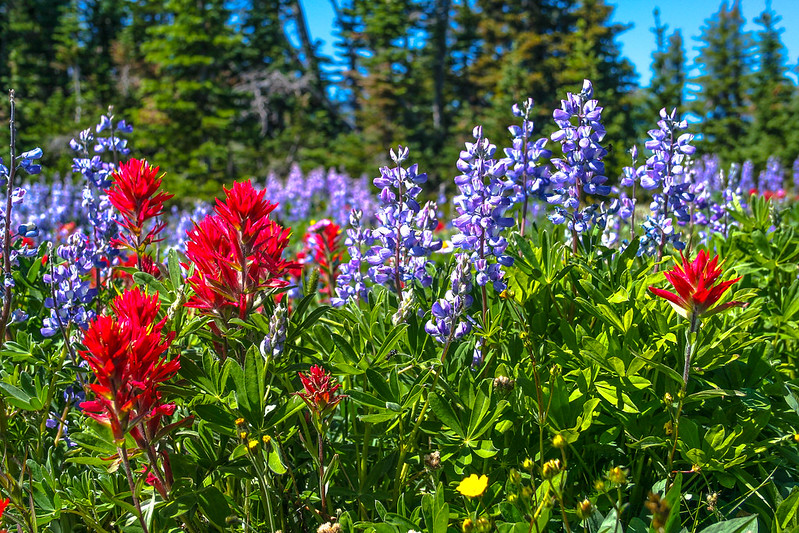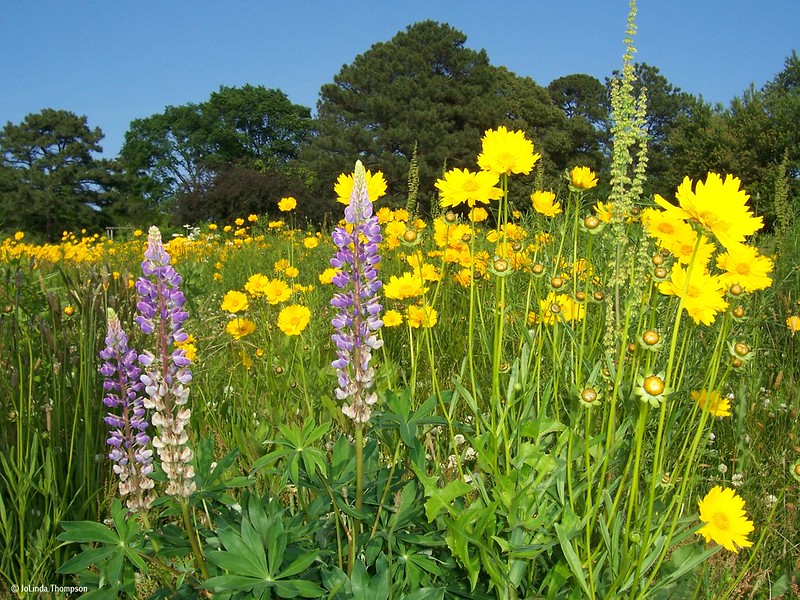Lupine is a large genus of plants in the pea family. Most species of lupines that are planted in gardens are either Lupinus perennis, the sundial lupine, Lupinus polyphyllus, large-leaved lupine, or hybrids. These summer-blooming perennials are grown for their spectacular spikes of flowers. Bloom color in lupines is highly variable, with blue, purple, yellow, pink, white, and even bi-colored flowers available.
Often, growing different varieties of lupines together is enough to create a colorful border, perennial garden, or container planting. However, lupines grow well with other perennials, shrubs, and annuals. Grow lupines and their companion plants in prairie or meadow gardens, cottage gardens, and naturalized areas.

Photo by Murray Foubister, unmodified, Flickr, copyright CC BY-SA 2.0 DEED
Lupines can grow in full or partial sun but perform best when they receive at least 5-6 hours of direct sunlight per day. Hardy to zones 3-8, lupines prefer growing in regions with mild summers. Lupine requires well-drained soil and moderate moisture. These perennials can tolerate sandy, acidic, and nutrient-poor soils. Lupines grow 1-3 feet tall and wide, leaving plenty of space for companion plants. However, lupines produce an abundance of pea-like seeds, which may spread and germinate in empty areas. Companion planting with lupines will help to reduce their self-seeding success.
Shrubs To Plant With Lupine
Lupines look lovely when planted in front of a shrub border. Shrubs grown for their foliage, such as boxwood or barberry, provide a nice backdrop to the colorful flowers of lupine. You can also complement lupine’s flower display with flowering shrubs that bloom at similar times. Roses, lilacs, and weigela are all drought-tolerant shrubs that grow well in sunny locations. These shrubs are available in numerous cultivars that provide late spring to summer flowers.
While roses and weigela rarely exceed 6-8 feet in height, lilacs can grow up to 4-15 feet tall. Be sure to keep the shrubs pruned to prevent them from shading out your lupine, and refrain from planting lupine directly in the shade of any shrubs or trees.
Perennials To Plant With Lupine
Lupine is ideal for planting with other sun-loving perennials. To create a cottage garden, grow lupine with garden favorites such as bee balm (Monarda), phlox, and false indigo (Baptisia). These perennial plants add traditional landscape charm in dense, informal plantings. Sea holly, Eryngium, is another perennial that thrives in similar conditions as lupine. The prickly, thistle-like appearance of sea holly contrasts nicely with the smooth, palmately compound leaves of lupine.
For a more natural meadow garden, plant lupines more closely together with their neighboring plants. North American native plants such as rudbeckia, coreopsis, blazing star (Liatris), mountain mint (Pycnanthemum), coneflowers (Echinacea), and milkweed (Asclepias) pair well with lupines in this setting.

Photo by JoLinda Thompson, unmodified, Flickr, copyright CC BY-ND 2.0 DEED
Annuals To Plant With Lupine
Because lupines are available in numerous flower colors, growing them with annuals will allow you to experiment with different color combinations and designs. Sunflowers are a classic companion plant for lupines, as they thrive in the same conditions and are available in many sizes and colors. Angelonia, also called summer snapdragon, is another annual that grows well with lupine. Their colorful spikes of flowers are a perfect match for those of lupine, creating a vibrant scene in summer. Plant salvia with lupine for a similar effect. Additionally, lupine is often planted in vegetable gardens since its root nodules are capable of nitrogen fixation via an association with soil microbes.
Best Companion Plants For Lupine in Containers
With its showy clusters of flowers, lupine acts as a marvelous thriller in containers. This perennial is a great focal point when paired with foliage plants such as coral bells (Heuchera) and ornamental grasses. For extra pops of color, choose flowering annuals that can act as both a filler and a spiller, including alyssum and lantana. These plants will help to create a full, eye-catching container arrangement. When growing lupine and other plants together in a container, be sure to let the soil dry out in between watering.
Plants Not To Grow With Lupine
Since lupine requires full or partial sun, do not plant trees or shrubs near it that will shade it out as they mature. Avoid choosing plants that need wet soil, such as cardinal flower (Lobelia cardinalis), since lupine will not tolerate the soil moisture levels needed to keep these plants alive. Because lupine can aggressively self-seed, do not plant it with small or slow-growing plants that can easily be outcompeted by lupine. Seedlings and young transplants should be planted away from lupine to ensure that lupine does not crowd them out.
Best Plants To Grow With Lupine
The best plants to grow with lupine are plants that like full to partial sun and well-drained soil. Flowering shrubs like lilacs and roses grow well with lupine, while foliage shrubs like boxwood provide a neutral, evergreen backdrop to lupine’s eye-catching flowers. Grow lupine with cottage garden and meadow plants like coneflowers, false indigo, sea holly, phlox, and bee balm. Sun-loving annuals, such as lantana and angelonia, can be grown with lupine in the ground or in containers.
 |
Lauren Youngcourt - Published 10-13-2023 |
